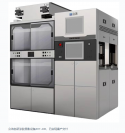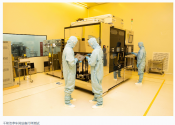Biden administration is just too weak to mend tie with China. It can't even postpone any sanction and ban for a few months before the APEC.
If you keep throwing shit at the wall eventually something will stick, hopefully.
Biden administration is just too weak to mend tie with China. It can't even postpone any sanction and ban for a few months before the APEC.
I agree. While the consumer standalone GPU market is small and will remain so for the foreseeable future, gaming GPU itself can have a pretty big market. IMO the future of gaming will be done through the cloud. Even 5G can sometimes achieve single digit microsecond latency, with 6G it might be possible to play demanding games via cloud computing. Consumer GPU market is weak because higher end cards can cost >$1000. Even gaming systems cost several hundred dollars plus the cost of games. Most of the time, those systems are sitting idle, and even when gaming they're oftentimes not utilizing their full power. Then you have all the games you've bought and aren't playing anymore, though this part is already being taken care of by subscription services.They will get to standalone GPU out long before 3nm process becomes available.
Have you missed both Moore thread and meta x getting into graphic rendering GPU? Application goes beyond just gamers and reach metaverse and cloud desktop. When it comes to Huawei, it's clearly not offering competitive product right now for people seeking gaming experience. Higher end GPU allows more competitive product in any kind of graphics rendering.
I suggest you go watch some of these review videos. Huawei is moving heaven and earth to make sure it has the best product. Seriously, please go watch the videos


Another ALD tool companyBecause in general they would have to admit that they were in the wrong, that they have low understanding of the industry that they are giving policies recommendations, that their research methods are very shallow and shortsighted and their policies recommendations could to lead to job and revenue losses. Is like Gordon Chan, he will rather die a painful death than to admit that he has been wrong for decades.
But what anyone can do.
He says, like most of his peer, uni-dimensional statements, in this case about China lacking ALD and epitaxial equipment without providing any details what kind of ALD or epi tools or for what part of the process or for what materials. like you have to take their words for granted.
ALD equipment has been one of the most fastest growing semiconductor equipment segment in China.
In the Epi market.
Alphasemi has been shipping their tools to major fabs since 2022
and AMEC is going to enter the frontend EPI market too.
And these companies are growing faster than their foreign counterparts.
Also China localization rate stand a 40% not at 20%.
I think you make a good point. They are already doing this right now for K9000S. In fact, they are patching features like frame filling just to deal with low FPS on hi-end gaming because their SoC uses too much power for higher FPS.
So, they could go with a larger SoC die to increase its performance, but that would still make power consumption & over heating a real problem.
If they can make a standalone GPU that gets installed on another part of the tablet and put a lot of heat dissipation around that too & optimize it, then you have 2 smaller heat centers vs 1 large heat center, easier to deal with.
And for laptops, you can have fans next to GPUs, so this is less of a concern.
For laptops, you generally don't do SoC. You have a CPU typically, so a Kunpeng-930 and then you'd want to pair it up with a GPU anyways for rendering and low end gaming.
I just see that given the amount of work they are already doing with Maleeon, it's a no brainer to go ahead with a full blown GPU. After all, the Ascend NPU also gets a scaled down version in Kirin-9000S
Based on that logic. Huawei should just not look into any smaller/niche areas then.I did rethink what you said, which is why I put the last sentence previously. I realize you are talking about GPU applications in general rather than just PCs (Although PCs were your original example)
As you said, cloud desktop (GPUaaS) is also a possibility.
Moore Threads can look to gaming as a much smaller company. Because there are only two players, neither is going to sacrifice their margins in a captive market. This is the possibility for a new entrant. For a multinational like Huawei, they would have better things to concentrate on.
you have two choices. Make your SoC larger to have more space for an integrated GPU. Or put a separate GPU on your tablet in a different location.In the space as cramped as a tablet, if you put in a GPU and separate cooling, you are basically losing space for battery, so its not really a great option.
Again, the need to do this is because K9000S cannot achieve same game playing performance as apple SoC.You are wrong about laptops, discrete GPUs for laptops are a dying breed and SoC is actually the mainstream now. AMD, Intel, and Apple are all integrated GPU and IO on the CPU package (AKA SoC). This is 90% of the market. nVidia just killed the GeForce MX. Only niche high end laptops have discrete higher end GPUs. As Apple has shown, you can have a high performing iGPU. Even AMD could squeeze more from iGPU, but customers are not willing to pay for it (remember the Intel/AMD Kaby Lake G mash up?)
so you want Huawei to loose competitiveness in tablet and laptops while hoping that SMIC will catch up to TSMC in 6 to 7 years?Of course, as noted, currently Huawei does not have access to the 3nm/5nm that AMD and Apple are using. However, should that change, I expect any sort of discrete GPUs to shift away from the consumer market.
Huawei Reportedly Receiving Assistance From Taiwanese Firms To Build An ‘Under-The-Radar’ Network Of Chip Plants
